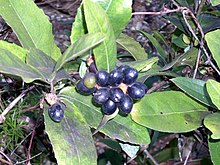
Antidesma is a genus of tropical plant in the family Phyllanthaceae formally described by Linnaeus in 1753. It is native to tropical Africa, S + E + SE Asia, Australia, and various oceanic islands. The greatest diversity occurs in Southeast Asia.

Flindersia is a genus of 17 species of small to large trees in the family Rutaceae. They have simple or pinnate leaves, flowers arranged in panicles at or near the ends of branchlets and fruit that is a woody capsule containing winged seeds. They grow naturally in Australia, the Moluccas, New Guinea and New Caledonia.

Patersonia, is a genus of plants whose species are commonly known as native iris or native flag and are native to areas from Malesia to Australia.
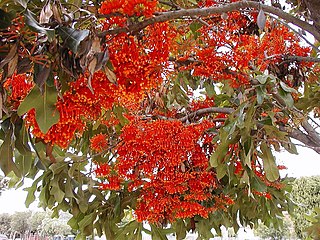
Stenocarpus is a genus of about 22 species of flowering plants in the family Proteaceae. They are trees or shrubs with variably-shaped leaves, zygomorphic, bisexual flowers, the floral tube opening on the lower side before separating into four parts, followed by fruit that is usually a narrow oblong or cylindrical follicle.

Lepiderema is a genus of eight species of trees in the lychee family Sapindaceae native to New Guinea and eastern Australia, plus one more from Queensland that is yet to be formally described. The type species is Lepiderema papuana.
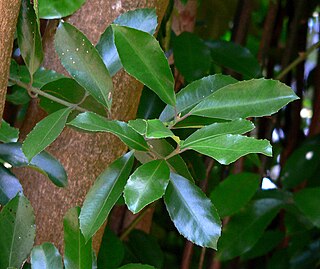
Hedycarya is a genus of about 16 species of flowering plants in the family Monimiaceae native to eastern Australia, New Zealand, and some Pacific Islands. Plants in the genus Hedycarya are shrubs, or small to medium trees with sometimes toothed leaves. The male and female flowers cup-shaped and are borne on separate plants. Male flowers usually have 8 tepals and many stamens and female flowers are have 6 to 12 tepals with many carpels. The fruit is a cluster of drupes.

Palmeria is a genus of about 17 species of flowering plants in the family Monimiaceae mostly native to Australia and New Guinea. One species is also native to Sulawesi and the Bismarck Archipelago. Plants in the genus Palmeria are woody climbers or climbing shrubs with usually 7 to 15 flowers, the flowers either male or female.
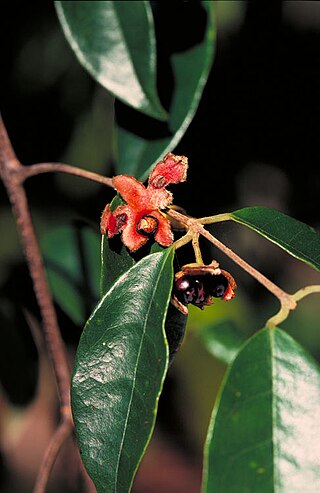
Palmeria scandens, commonly known as anchor vine or pomegranate vine, is a species of flowering plant in the family Monimiaceae and is native to Queensland, New South Wales and New Guinea. It is a woody vine with elliptic to oblong leaves and male and female flowers borne on separate plants, male flowers usually with thirty to forty stamens and female flowers with about ten carpels. The fruit is green, splitting to form a pinkish receptacle with 3 to 7 black or red drupes.

Seringia is a genus of about 18 species of plants in the family Malvaceae. Species of Seringia are native to Australia, New Guinea, and Madagascar. They are small shrubs with soft silken leaves. The flowers are purple or mauve and appear in profusion. The calyx is the most conspicuous part of the flower.

Pendressia wardellii is a species of flowering plant in the family Monimiaceae, and is the sole species in the genus Pendressia. It is a tall shrub to small tree endemic to north-eastern Queensland. It has egg-shaped to elliptic leaves, male flowers and female flowers on separate plants, male flowers with 10 to 15 stamens and female flowers with 8 to 10 carpels, and red drupes.

Palmeria hypotephra is a species of flowering plant in the family Monimiaceae and is endemic to Queensland. It is a woody climber with elliptic to egg-shaped leaves, male and female flowers on separate plants with 4 or 5 tepals, male flowers with 30 to 35 stamens, female flowers with 10 to 12 carpels, and spherical, dark brown to black drupes.

Palmeria foremanii, commonly known as anchor vine, is a species of flowering plant in the family Monimiaceae and is endemic to an area near the New South Wales - Queensland border. It is a tall, woody climber or scrambling shrub with usually elliptic leaves, male and female flowers on separate plants with 5 tepals, male flowers with 40 to 43 stamens, female flowers with 7 to 12 carpels, and spherical, shiny black drupes.
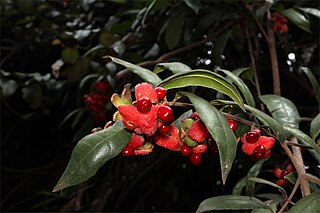
Palmeria racemosa is a species of flowering plant in the family Monimiaceae and is endemic to eastern Australia. It is a woody vine with elliptic to oblong leaves and male and female flowers borne on separate plants, male flowers usually with thirty to forty stamens and female flowers with about ten carpels. The fruit is green, splitting to form a pinkish receptacle with 3 to 7 black or red drupes.
Wilkiea hugeliana is a species of flowering plant in the family Monimiaceae, and is endemic to Cape York Peninsula in far northern Queensland. It is a shrub or small tree with elliptic, sometimes toothed leaves, and male and female flowers on separate plants. Male flowers usually have 4 pairs of stamens and female flowers have about 40 carpels, and the fruit is a glossy black drupe with enlarged orange receptacles.
Wilkiea kaarruana is a species of flowering plant in the family Monimiaceae, and is endemic to northern Queensland. It is a shrub or small tree with elliptic to oblong leaves, and male and female flowers on separate plants, each with 4 to 6 tepals. Male flowers usually have 2 pairs of stamens and female flowers have about 21 to 26 carpels.
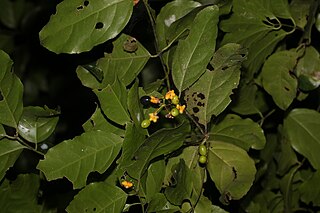
Wilkiea longipes is a species of flowering plant in the family Monimiaceae, and is endemic to northern Queensland. It is a shrub or small tree with elliptic to egg-shaped leaves with the narrower end towards the base, and male and female flowers on separate plants. Male flowers usually have 3 or 4 pairs of stamens and female flowers have about 9 to 13 carpels.

Wilkiea macrophylla, commonly known as large-leaved wilkiea, is a species of flowering plant in the family Monimiaceae, and is endemic to north-eastern Australia. It is a glabrous shrub or small tree with narrowly to broadly elliptic leaves, and male and female flowers on separate plants. Male flowers have 2 pairs of tepals and usually 2 pairs of stamens, and female flowers have 6 or 7 pairs of tepals and 13 to 20 carpels. The fruit is a glossy purplish to olive black drupe.

Wilkiea pubescens is a species of flowering plant in the family Monimiaceae, and is endemic to north Queensland. It is a shrub or small tree with elliptic leaves and male and female flowers on separate plants. Male flowers have 6 tepals and 2 or 3 pairs of stamens and female flowers have 2 pairs of tepals and 15 to 30 carpels. The fruit is a purplish-black drupe.
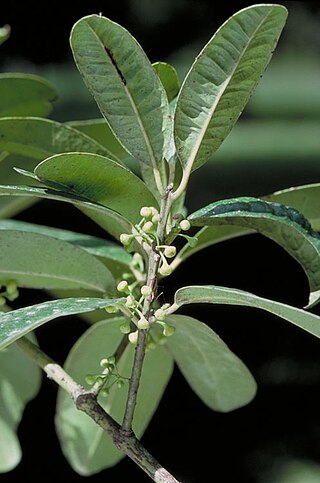
Wilkiea rigidifolia is a species of flowering plant in the family Monimiaceae, and is native to north Queensland and New Guinea. It is a shrub or small tree with elliptic to broadly elliptic or oblong leaves and male and female flowers on separate plants. Male flowers are borne in clusters of 20 to 30 and have 4 pairs of tepals and 2 or 3 pairs of stamens and female flowers have 2 pairs of tepals and 40 to 50 carpels. The fruit is a glossy black drupe.
Wilkiea smithii is a species of flowering plant in the family Monimiaceae, and is endemic to north-eastern Queensland. It is a shrub or small, slender tree with elliptic or oblong leaves and male and female flowers on separate plants. Male flowers are borne in clusters of about 5 and have 8 tepals and 2 pairs of stamens and female flowers have 20 to 40 carpels. The fruit is a glaucous, purplish to black drupe.
